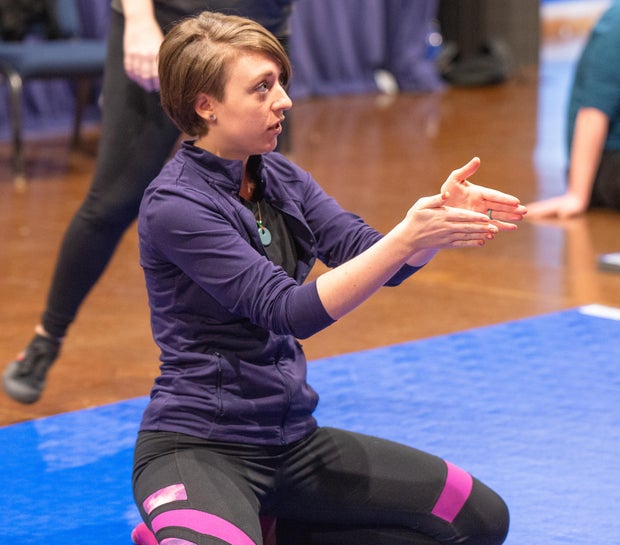CBS News
“We’re not the sex police”: Here’s what intimacy coordinators actually do on film and TV sets

More than 70% of Americans say a rewarding career or job is extremely important for them to live a fulfilling life — more important than family, friends or wealth. CBS News interviewed a broad array of workers who chose unique jobs, for a series we call: Unique jobs, extraordinary lives.
Have you ever heard of an intimacy coordinator? Most people don’t know they are the professionals who help bring intimate scenes to life on screens.
“We are there to help coordinate any scene with simulated sex acts, nudity, or vulnerable scenes,” explained Amy Northrup, a New York City-based intimacy coordinator for film and television.
Intimacy coordination is a relatively new and growing field. The first production to hire and credit a designated intimacy coordinator was HBO’s “The Deuce,” starring James Franco and Maggie Gyllenhaal, which premiered in 2017 and depicted the porn industry in 1970s New York City.
There are more than 100 certified intimacy coordinators working on film and television sets today. Their pay is roughly in line with that of stunt coordinators, whose minimum rates the union sets are about $1,500 a day. They make, on average, between $60,000 to $90,000 per year.
In its latest union contract, the Screen Actors Guild-American Federation of Television and Radio Artists (SAG-AFTRA) stated that productions must make a good-faith effort to hire intimacy coordinators when necessary. According to the Motion Picture Association, the film and television industry employs 2.74 million people and pays more than $242 billion in wages annually to everyone from stunt performers to hair and makeup artists across domestic productions.
Northup told CBS News she gets frequent questions about the career path she took to instruct a pair of actors to “make love” based on a script that offers few other descriptive details. She said intimacy coordinators need to bring a variety of skills to set in order to make actors feel comfortable performing such scenes.
“We’re not the sex police”
The perception of what intimacy coordinators do on set has evolved too — producers and directors have come to lean on them for guidance to realistically depict “vulnerable” moments on screen. “Vulnerable” scenes can also include an actor depicting someone giving birth or someone in a wheelchair being bathed. A scene with breastfeeding or that shows a gynecological appointment would qualify too.
“Anything asking people to put their bodies in a hyper-exposed, vulnerable state is where intimacy coordinators can be effective team members,” Northrup told CBS News.
Actor Zendaya recently spoke publicly about how working with an intimacy coordinator on scenes filmed for director Luca Guadagnino’s “Challengers,” whose story follows a love triangle, made her feel safe and comfortable while filming intimate scenes with her co-stars.
Marilla Sicilia/Archivio Marilla Sicilia/Mondadori Portfolio via Getty Images
“It’s really expanded in last five years and people recognize that intimacy coordinators are creative resources who come with dramaturgy expertise around sex and sexuality,” Northup said. “We are not the human resources department, we’re not the sex police.”
Much of the work Northup and her colleagues do takes place before the cameras start rolling. That can include talking to directors about how they envision scenes unfolding, and what precise positions they want actors’ bodies in — details that aren’t always included in scripts.
“Scenes are usually written as ‘They go at it,’ or ‘They make love,'” Northup said. “For one director it could mean they kiss, fall into bed and the camera directs away. For another it would be we stay on them, one person climbs on top, and there’s a moment that could be really detailed. So the first thing we ask the director is, ‘What are you picturing? What are shot setups, what is the body positioning, the degree of nudity, what actual sex acts do they engage in?'”
Other times intimacy coordinators must consider actions to keep actors safe such as making sure an actor’s scene partner doesn’t eat peanuts because someone has a peanut allergy and kissing them would be dangerous.
Navigate the “messiness” of human interaction
There’s no traditional career path to become an intimacy coordinator. The job requires a unique blend of skills that intimacy pros working today might have picked up working as actors or in other film industry roles.
It also demands soft skills that are harder to teach, like a certain demeanor and a gentle touch.
“We are here to help navigate the messiness of human interaction. Demeanor-wise, it’s important to bring levity to the role, a light touch, and to be expert at de-escalating and intervening in a way that no one knows it happened,” Northup said.
While professionals don’t need certification to work, several training programs meet SAG-AFTRA’s standards. The union maintains a list of about 70 registered intimacy coordinators. Jessica Steinrock is the founder and CEO of SAG-AFTRA accredited Intimacy Directors and Coordinators, which she says has certified about 100 professionals.
Among other topics, certification programs teach consent training, movement coaching techniques, modesty garment and barrier application, and bystander intervention protocols.
Isaak Berliner
While certification is one way to demonstrate qualification, Steinrock noted that many capable intimacy practitioners aren’t officially certified. On-set experience is always helpful, too, and some intimacy pros balance coordination with work as actors, assistant directors or the costume team.
Lucy Shapiro, a seasoned costume designer who has worked on TV series including “Life and Beth and “Only Murders in the Building,” said there’s a crossover between what her department does and intimacy coordination. She even founded a company, Covvier, that makes modesty garments with protective barriers for actors to wear while filming nude or intimate scenes.
Previously, she and other costumers made use of shoe insoles, yoga mats and deflated pilates balls to create barriers between actors filming intimate scenes.
“It wasn’t until intimacy coordinators came around and said there should be a standard garment that we started our company,” she told CBS MoneyWatch. “Working side by side with intimacy coordinators has been such an industry change and has made it so much better to everyone all around.”
CBS News
A study to devise nutritional guidance just for you

It’s been said the best meals come from the heart, not from a recipe book. But at this USDA kitchen, there’s no pinch of this, dash of that, no dollops or smidgens of anything. Here, nutritionists in white coats painstakingly measure every single ingredient, down to the tenth of a gram.
Sheryn Stover is expected to eat every crumb of her pizza; any tiny morsels she does miss go back to the kitchen, where they’re scrutinized like evidence of some dietary crime.
Stover (or participant #8180, as she’s known) is one of some 10,000 volunteers enrolled in a $170 million nutrition study run by the National Institutes of Health. “At 78, not many people get to do studies that are going to affect a great amount of people, and I thought this was a great opportunity to do that,” she said.
CBS News
It’s called the Nutrition for Precision Health Study. “When I tell people about the study, the reaction usually is, ‘Oh, that’s so cool, can I do it?'” said coordinator Holly Nicastro.
She explained just what “precise” precisely means: “Precision nutrition means tailoring nutrition or dietary guidance to the individual.”
The government has long offered guidelines to help us eat better. In the 1940s we had the “Basic 7.” In the ’50s, the “Basic 4.” We’ve had the “Food Wheel,” the “Food Pyramid,” and currently, “My Plate.”
CBS News
They’re all well-intentioned, except they’re all based on averages – what works best for most people, most of the time. But according to Nicastro, there is no one best way to eat. “We know from virtually every nutrition study ever conducted, we have inner individual variability,” she said. “That means we have some people that are going to respond, and some people that aren’t. There’s no one-size-fits-all.”
The study’s participants, like Stover, are all being drawn from another NIH study program called All Of Us, a massive undertaking to create a database of at least a million people who are volunteering everything from their electronic health records to their DNA. It was from that All of Us research that Stover discovered she has the gene that makes some foods taste bitter, which could explain why she ate more of one kind of food than another.
Professor Sai Das, who oversees the study at Tufts University, says the goal of precision nutrition is to drill down even deeper into those individual differences. “We’re moving away from just saying everybody go do this, to being able to say, ‘Okay, if you have X, Y and Z characteristics, then you’re more likely to respond to a diet, and somebody else that has A, B and C characteristics will be responding to the diet differently,'” Das said.
It’s a big commitment for Stover, who is one of 150 people being paid to live at a handful of test sites around the country for six weeks – two weeks at a time. It’s so precise she can’t even go for a walk without a dietary chaperone. “Well, you could stop and buy candy … God forbid, you can’t do that!” she laughed.
While she’s here, everything from her resting metabolic rate, her body fat percentage, her bone mineral content, even the microbes in her gut (digested by a machine that essentially is a smart toilet paper reading device) are being analyzed for how hers may differ from someone else’s.
Nicastro said, “We really think that what’s going on in your poop is going to tell us a lot of information about your health and how you respond to food.”
CBS News
Stover says she doesn’t mind, except for the odd sounds the machine makes. While she is a live-in participant, thousands of others are participating from their homes, where electronic wearables track all kinds of health data, including special glasses that record everything they eat, activated when someone starts chewing. Artificial intelligence can then be used to determine not only which foods the person is eating, but how many calories are consumed.
This study is expected to be wrapped up by 2027, and because of it, we may indeed know not only to eat more fruits and vegetables, but what combination of foods is really best for us. The question that even Holly Nicastro can’t answer is, will we listen? “You can lead a horse to water; you can’t make them drink,” she said. “We can tailor the interventions all day. But one hypothesis I have is that if the guidance is tailored to the individual, it’s going to make that individual more likely to follow it, because this is for me, this was designed for me.”
For more info:
Story produced by Mark Hudspeth. Editor: Ed Givnish.
“Sunday Morning” 2024 “Food Issue” recipe index
Delicious menu suggestions from top chefs, cookbook authors, food writers, restaurateurs, and the editors of Food & Wine magazine.
CBS News
A new generation of shopping cart, with GPS and AI

Watch CBS News
Be the first to know
Get browser notifications for breaking news, live events, and exclusive reporting.
CBS News
“All hands on deck” for Idaho’s annual potato harvest

Watch CBS News
Be the first to know
Get browser notifications for breaking news, live events, and exclusive reporting.







